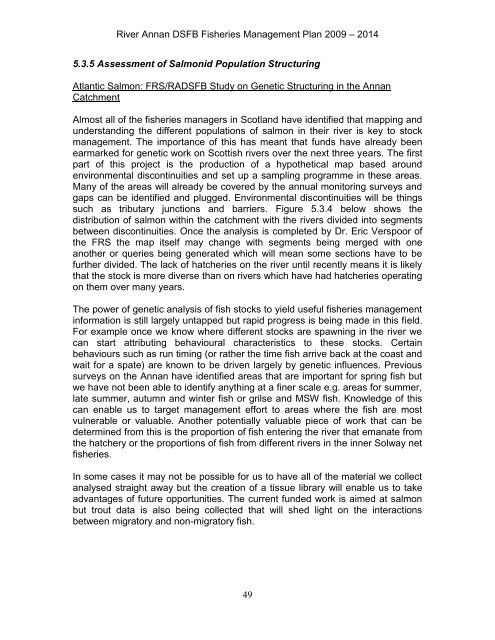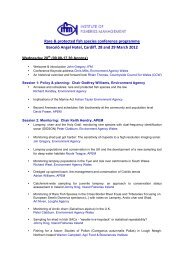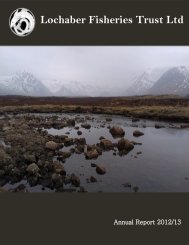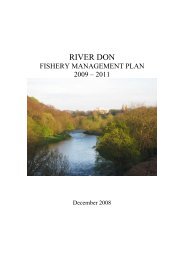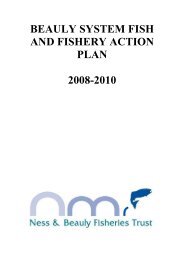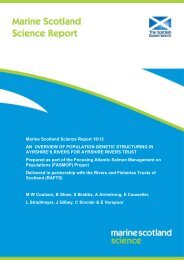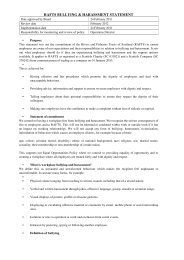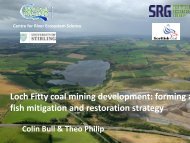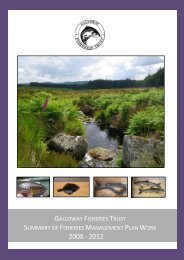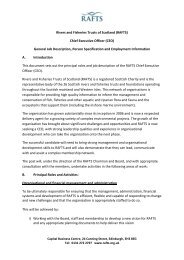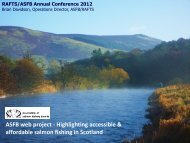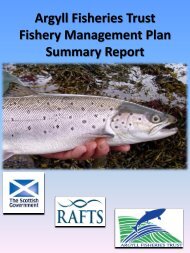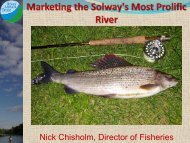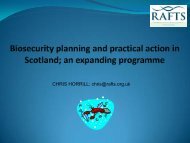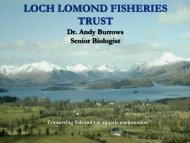Create successful ePaper yourself
Turn your PDF publications into a flip-book with our unique Google optimized e-Paper software.
River <strong>Annan</strong> DSFB Fisheries <strong>Management</strong> <strong>Plan</strong> 2009 – 20145.3.5 Assessment of Salmonid Population StructuringAtlantic Salmon: FRS/RADSFB Study on Genetic Structuring in the <strong>Annan</strong>CatchmentAlmost all of the fisheries managers in Scotland have identified that mapping andunderstanding the different populations of salmon in their river is key to stockmanagement. The importance of this has meant that funds have already beenearmarked for genetic work on Scottish rivers over the next three years. The firstpart of this project is the production of a hypothetical map based aroundenvironmental discontinuities and set up a sampling programme in these areas.Many of the areas will already be covered by the annual monitoring surveys andgaps can be identified and plugged. Environmental discontinuities will be thingssuch as tributary junctions and barriers. Figure 5.3.4 below shows thedistribution of salmon within the catchment with the rivers divided into segmentsbetween discontinuities. Once the analysis is completed by Dr. Eric Verspoor ofthe FRS the map itself may change with segments being merged with oneanother or queries being generated which will mean some sections have to befurther divided. The lack of hatcheries on the river until recently means it is likelythat the stock is more diverse than on rivers which have had hatcheries operatingon them over many years.The power of genetic analysis of fish stocks to yield useful fisheries managementinformation is still largely untapped but rapid progress is being made in this field.For example once we know where different stocks are spawning in the river wecan start attributing behavioural characteristics to these stocks. Certainbehaviours such as run timing (or rather the time fish arrive back at the coast andwait for a spate) are known to be driven largely by genetic influences. Previoussurveys on the <strong>Annan</strong> have identified areas that are important for spring fish butwe have not been able to identify anything at a finer scale e.g. areas for summer,late summer, autumn and winter fish or grilse and MSW fish. Knowledge of thiscan enable us to target management effort to areas where the fish are mostvulnerable or valuable. Another potentially valuable piece of work that can bedetermined from this is the proportion of fish entering the river that emanate fromthe hatchery or the proportions of fish from different rivers in the inner Solway netfisheries.In some cases it may not be possible for us to have all of the material we collectanalysed straight away but the creation of a tissue library will enable us to takeadvantages of future opportunities. The current funded work is aimed at salmonbut trout data is also being collected that will shed light on the interactionsbetween migratory and non-migratory fish.49


